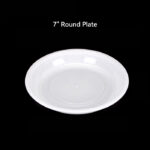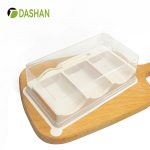PFAS, or “forever chemicals,” pose health and environmental risks. PFAS-Free products in cookware and packaging reduce exposure, supporting safer, sustainable alternatives.
Introduction: What Are PFAS and Why PFAS-Free Matters
Per- and polyfluoroalkyl substances (PFAS), commonly known as “forever chemicals,” are a class of synthetic compounds that have been in use since the 1950s. They are valued for their resistance to heat, water, and oil, which has made them widely applied in non-stick cookware, water-repellent clothing, stain-resistant fabrics, firefighting foams, and grease-proof packaging.
While these properties have been useful in daily life, they come at a cost. PFAS do not easily break down in the environment or the human body, leading to long-term persistence. As growing evidence points to health risks, the call for PFAS-free alternatives has intensified. Choosing PFAS-free is no longer just a trend—it is becoming a necessity for sustainable and healthier living.
Understanding PFAS and Their Impact

PFAS include thousands of chemical variants, many of which have been detected in water, soil, and even human blood samples worldwide. Their defining feature, the carbon-fluorine bond, is one of the strongest in chemistry. This stability explains why PFAS are resistant to degradation, earning them the nickname “forever chemicals.”
The persistence of PFAS raises concerns about bioaccumulation. Once released into the environment, these chemicals build up in ecosystems and the human body, often with no clear way of removal. The result is widespread contamination that continues to expand globally, prompting urgent action to reduce exposure.
Health Implications of PFAS Exposure
Research suggests that long-term exposure to PFAS may be associated with various health risks. Although scientific studies are still evolving, evidence has linked PFAS to:
-
-
-
Elevated cholesterol levels
-
Liver damage and changes in enzyme activity
-
Reproductive and developmental issues
-
Immune system suppression
-
Hormonal disruption and potential links to certain cancers
-
-
Not all PFAS pose the same level of risk, but their widespread presence in consumer products and the environment makes exposure difficult to avoid. This ongoing uncertainty has fueled public demand for safer alternatives, driving the PFAS-free movement forward.
The PFAS-Free Movement: A Response to Growing Concerns
The term “PFAS-free” signifies that a product has been manufactured without the use of these harmful chemicals. This concept extends beyond safety—it represents a commitment to health, transparency, and environmental responsibility.
Manufacturers in various industries are now racing to develop PFAS-free versions of their products. In cookware, ceramic-coated pans and stainless-steel alternatives are becoming popular replacements for traditional non-stick coatings. In packaging, materials like sugarcane bagasse, bamboo, and kraft paper are offering safe and compostable solutions.
By eliminating PFAS, companies can reassure consumers that their products are safe for daily use while also demonstrating a commitment to reducing long-term pollution.
Regulatory Actions and Industry Responses
Governments around the world have begun addressing the PFAS issue with stricter regulations.
-
-
-
Europe: The European Commission is considering a ban on PFAS in consumer products, with limited exemptions for essential industrial uses.
-
United States: Several states, including Maine and California, have enacted bans on PFAS in food packaging and firefighting gear, recognizing the risks to both public health and frontline workers.
-
Private Sector: Companies are reformulating products voluntarily. Cookware brands such as GreenPan and De Buyer offer PFAS-free non-stick pans, while retailers like McDonald’s and Starbucks have pledged to phase out PFAS in packaging.
-
-
These steps highlight the growing recognition that PFAS-free is not only preferable but necessary for global health and safety.
Challenges in Identifying PFAS-Free Products
While PFAS-free products are on the rise, identifying them remains a challenge for consumers. Labels are often inconsistent, and transparency across the supply chain is limited.
Some products may claim to be “eco-friendly” without clearly stating whether they are PFAS-free. This lack of clarity puts consumers at risk of unknowingly purchasing items containing harmful chemicals.
Organizations like Toxic-Free Future have evaluated major retailers on their chemical policies, finding that many still fall short of meaningful PFAS-free commitments. This underscores the need for standardized labeling and greater accountability across industries.
To ensure safety, consumers should look for certifications such as “PFAS-free,” “fluorine-free,” or third-party laboratory testing results that verify the absence of fluorinated compounds.
The Path Forward: Safer PFAS-Free Alternatives
The movement toward PFAS-free products is gaining momentum, supported by governments, manufacturers, and consumers alike.
-
-
-
Government Guides: States like Massachusetts have issued PFAS-Free Buying Guides to help consumers identify safe alternatives.
-
EPA Resources: The U.S. Environmental Protection Agency provides updated information on PFAS risks and guidance for avoiding exposure.
-
Consumer Choices: Increasingly, people are choosing cookware sets like Calphalon Classic Stainless Steel or Caraway Nonstick Ceramic, which provide safe cooking surfaces without PFAS.
-
-
In food packaging, PFAS-free options like sugarcane bagasse trays and bamboo fiber containers offer not only safety but also compostability, reducing long-term environmental impact.
Together, these solutions represent a healthier and more sustainable future.
Conclusion
The shift toward PFAS-free products reflects a broader commitment to environmental stewardship and human health. “PFAS-free” is more than a label—it is a guarantee that harmful forever chemicals are being phased out of the products we use daily.
Consumers play a vital role by demanding transparency and choosing PFAS-free alternatives. Manufacturers must continue innovating safe materials, while governments enforce stronger regulations to protect public health.
As the world learns more about the dangers of PFAS, embracing PFAS-free solutions marks an important step toward a safer, cleaner, and more sustainable future.
FAQ
1. What does PFAS-free mean?
PFAS-free means a product does not contain per- and polyfluoroalkyl substances, a group of man-made chemicals linked to environmental persistence and potential health risks.
2. Why are PFAS considered harmful?
PFAS are often called “forever chemicals” because they do not break down easily. They can accumulate in the body and have been linked to cancer, hormone disruption, and immune issues.
3. Where are PFAS commonly found?
PFAS are used in nonstick cookware, water-repellent fabrics, grease-resistant food packaging, and some disposable tableware. Many manufacturers are now phasing them out.
4. How can I tell if a product is PFAS-free?
Look for labels or certifications such as “PFAS-free,” “fluorine-free,” or independent lab testing results that confirm the product is free from fluorinated compounds.
5. Are PFAS-free food containers safe for hot and greasy foods?
Yes, certified PFAS-free containers are designed to resist heat and oil using safe alternatives like PLA coatings or high-quality natural fibers like bagasse.
6. What are the benefits of choosing PFAS-free packaging?
Choosing PFAS-free helps reduce long-term exposure to toxic substances, supports better health, and minimizes environmental contamination during disposal or composting.
7. Are PFAS-free products also biodegradable or compostable?
Many PFAS-free products are also compostable, especially those made from bagasse, bamboo, or kraft paper. Always check if the product is certified for compostability.
Source List
-
-
-
“How PFAS Impacts Your Health” – Agency for Toxic Substances and Disease Registry (ATSDR)
https://www.atsdr.cdc.gov/pfas/about/health-effects.html -
“PFAS Exposure and Risk of Cancer” – National Cancer Institute (NCI)
https://dceg.cancer.gov/research/what-we-study/pfas -
“Per- and Polyfluoroalkyl Substance Toxicity and Human Health Review” – Bevin E. Blake and Suzanne E. Fenton
https://pmc.ncbi.nlm.nih.gov/articles/PMC7906952/ -
“Want to Avoid Forever Chemicals? Here Are Nine of the Best PFAS-Free Frying Pans” – The Guardian
https://www.theguardian.com/thefilter/2025/feb/28/best-pfas-free-frying-pans -
“PFAS-Free Coatings Market Worth $1.5 Billion by 2030” – MarketsandMarkets
https://www.marketsandmarkets.com/PressReleases/pfas-free-coatings.asp -
“Retailers Committing to Phase Out PFAS as a Class in Food Packaging and Products” – Toxic-Free Future
https://toxicfreefuture.org/mind-the-store/retailers-committing-to-phase-out-pfas-as-a-class-in-food-packaging-and-products/ -
“Per- and Polyfluoroalkyl Substances” – Wikipedia Contributors
https://en.wikipedia.org/wiki/Per-_and_polyfluoroalkyl_substances
-
-





